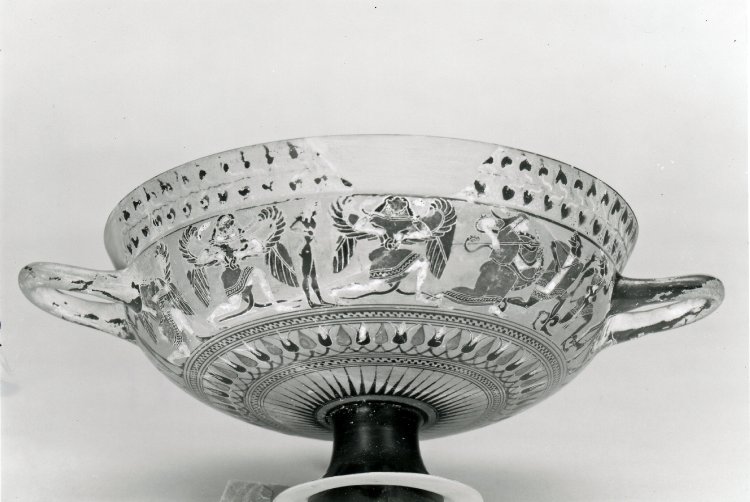Chapter 2: The Olympians
Previous Page Table of Contents Next Page
♠ Homer, Iliad 18.203-4
but Achilles, dear to Zeus, roused him, and round about his mighty shoulders Athene flung her tasselled aegis. Greek Text
♠ Homer, Iliad 24.20-21
and with the golden aegis he covered him wholly, that Achilles might not tear his body as he dragged him. Greek Text
♠ Homer, Iliad 5.741-42
and therein is the head of the dread monster, the Gorgon, dread and awful, a portent of Zeus that beareth the aegis. Greek Text
♠ Homer, Odyssey 22.297-98
Then Athena held up her aegis, the bane of mortals, on high from the roof, and the minds of the wooers were panic-stricken. Greek Text
♠ Hesiod, Aspis 343-44
for the goddess bright-eyed Athena put mettle into them by shaking her aegis. Greek Text
♦ London, British Museum B380: Attic black-figure cup by the C Painter, Medusa giving birth to Pegasos, Chrysaor (twice), Medusa’s two Gorgon sisters, Athena, Hermes and Perseus



C. Smith, “Four Archaic Vases from Rhodes,” Journal of Hellenic Studies 5 (1884), pl. 43 bottom (details of entire side and Athena)
Beazley Archive Pottery Database
♠ Pindar fr 70b.17-18 SM – Pindarus 2, p. 74, ed. B. Snell and H. Maehler. Leipzig 1975.
♠ Euripides, Ion 986-96
Tutor
I would be your servant in both these respects.
Creusa
Listen, then; you know the battle of the giants?
Tutor
Yes, the battle the giants fought against the gods in Phlegra.
Creusa
There the earth brought forth the Gorgon, a dreadful monster.
Tutor
As an ally for her children and trouble for the gods?
Creusa
Yes; and Pallas, the daughter of Zeus, killed it.
Tutor
[What fierce shape did it have?
Creusa
A breastplate armed with coils of a viper.]
Tutor
Is this the story which I have heard before?
Creusa
That Athena wore the hide on her breast.
Tutor
And they call it the aegis, Pallas’ armor?
Creusa
It has this name from when she darted to the gods’ battle. Greek Text
♠ Pseudo-Eratosthenes, Katasterismoi 13 – Mythographi Graeci vol. 3.1, pp. 16-18, ed. A. Olivieri. Leipzig 1897.
♠ Homer, Iliad 5.734-35
But Athene, daughter of Zeus that beareth the aegis, let fall upon her father’s floor her soft robe, richly broidered, that herself had wrought and her hands had fashioned. Greek Text
♠ Homer, Iliad 14.178-79
Then she clothed her about in a robe ambrosial, which Athene had wrought for her with cunning skill, and had set thereon broideries full many. Greek Text
♠ Homer, Iliad 9.390
and in handiwork were the peer of flashing-eyed Athene. Greek Text
♠ Homer, Iliad 5.59-63
And Meriones slew Phereclus, son of Tecton, Harmon’s son, whose hands were skilled to fashion all manner of curious work; for Pallas Athene loved him above all men. He it was that had also built for Alexander the shapely ships, source of ills. Greek Text
♠ Homer, Iliad 15.410-12
But as the carpenter’s line maketh straight a ship’s timber in the hands of a cunning workman, that is well skilled in all manner of craft by the promptings of Athene. Greek Text
♠ Homer, Odyssey 6.233-34
And as when a man overlays silver with gold, a cunning workman whom Hephaestus and Pallas Athena have taught all manner of craft, and full of grace is the work he produces. Greek Text
♠ Homeric Hymn to Aphrodite 5.7-15
First is the daughter of Zeus who holds the aegis, bright-eyed Athena; for she has no pleasure in the deeds of golden Aphrodite, but delights in wars and in the work of Ares, in strifes and battles and in preparing famous crafts. She first taught earthly craftsmen to make chariots of war and cars variously wrought with bronze, and she, too, teaches tender maidens in the house and puts knowledge of goodly arts in each one’s mind. Greek Text
♠ Pindar, Olympian 13.63-72 Bellerophon, who once suffered greatly when beside the spring he wanted to harness Pegasus, the son of the snake-entwined Gorgon; until the maiden Pallas brought to him a bridle with golden cheek-pieces. The dream suddenly became waking reality, and she spoke: “Are you sleeping, king, son of Aeolus? Come, take this charm for the horse; and, sacrificing a white bull, show it to your ancestor, Poseidon the Horse-Tamer.” The goddess of the dark aegis seemed to say such words to him as he slumbered in the darkness, and he leapt straight up to his feet. Greek Text
♦ Paris, Musée de Louvre G104, Attic cup by the Panaitios Painter, Athena, Theseus, Amphitrite

♦ Berlin, Antikensammlung F2179: Attic red-figure hydria by the Syleus Painter, Theseus, Athena, Dionysos and Ariadne

E. Gerhard, Etruskische und Kampanische Vasenbilder des Königlichen Museums zu Berlin (1843), pls. 6-7
Beazley Archive Pottery Database
Previous Page Table of Contents Next Page
Tags:
#Amphitrite, #Ariadne, #Athena, #Dionysos, #Gorgons, #Medousa, #Pegasos, #Perseus, #Theseus
Artistic sources edited by R. Ross Holloway, Elisha Benjamin Andrews Professor Emeritus, Joukowsky Institute for Archaeology and the Ancient World, Brown Univ., and Frances Van Keuren, Prof. Emerita, Lamar Dodd School of Art, Univ. of Georgia, June 2019.
Literary sources edited by Elena Bianchelli, Retired Senior Lecturer of Classical Languages and Culture, Univ. of Georgia, January 2021
1,059 total views, 1 views today